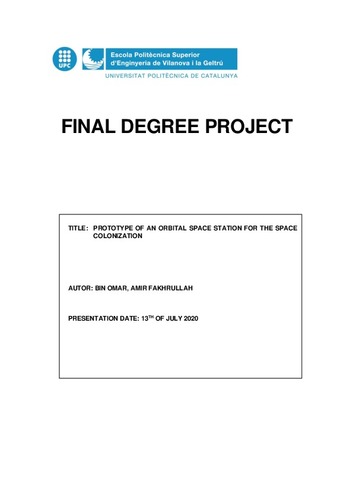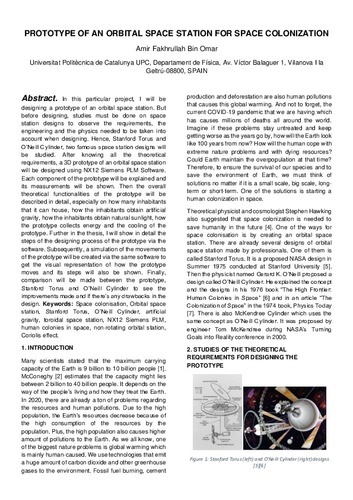Mostra el registre d'ítem simple
Prototype of an orbital space station for the space colonization
| dc.contributor | Moreno Lupiáñez, Manuel |
| dc.contributor.author | Bin Omar, Amir Fakhrullah |
| dc.contributor.other | Universitat Politècnica de Catalunya. Departament de Física |
| dc.date.accessioned | 2021-01-19T11:49:21Z |
| dc.date.available | 2021-01-19T11:49:21Z |
| dc.date.issued | 2020-07-13 |
| dc.identifier.uri | http://hdl.handle.net/2117/335515 |
| dc.description.abstract | [CAT] La idea de la colonització espacial s'ha suggerit des de la dècada de 1990 com la resposta per mantenir la supervivència a llarg termini de la civilització humana. L'estació espacial orbital és un dels tipus de colonització espacial diferents de la planeta terraformante. Molts dissenys per a l'estació espacial orbital havien estat realitzats per professionals de la física, enginyers, mestres i investigadors. En aquest projecte en particular, dissenyaré un prototip d'una estació espacial orbital. Però abans de dissenyar, s'han de realitzar estudis sobre dissenys d'estacions espacials per observar els requisits, l'enginyeria i la física s'han de tenir en compte a l'dissenyar. Per tant, estudiaré Stanford Torus i Cilindre O'Neill, 2 dissenys famosos d'estacions espacials. Després de conèixer tots els requisits teòrics, dissenyaré un prototip 3D d'una estació espacial orbital utilitzant el programari NX12 Siemens PLM. Explicaré cada component de l'prototip i mostraré les seves mesures. Després, descriuré en detall les funcionalitats teòriques generals de l'prototip, especialment sobre quants habitants pot albergar, com els habitants obtenen gravetat artificial, com els habitants obtenen llum solar natural, com el prototip recol·lecta energia i el refredament de l'prototip. Més endavant en la memòria, mostraré en detall els passos de el procés de disseny de l'prototip a través del programari. Posteriorment, crearé una simulació dels moviments de l'prototip a través del mateix programari per obtenir una representació visual de com es mou el prototip. També mostraré els seus passos. Finalment, faré una comparació entre el prototip, Stanford Torus i Cilindre O'Neill per veure les millores realitzades i si hi ha algun inconvenient en el disseny. |
| dc.description.abstract | [ESP] La idea de la colonización espacial se ha sugerido desde la década de 1990 como la respuesta para mantener la supervivencia a largo plazo de la civilización humana. La estación espacial orbital es uno de los tipos de colonización espacial distintos del planeta terraformante. Muchos diseños para la estación espacial orbital habían sido realizados por profesionales de la física, ingenieros, maestros e investigadores. En este proyecto en particular, diseñaré un prototipo de una estación espacial orbital. Pero antes de diseñar, se deben realizar estudios sobre diseños de estaciones espaciales para observar los requisitos, la ingeniería y la física deben tenerse en cuenta al diseñar. Por lo tanto, estudiaré Stanford Torus y Cilindro O'Neill, 2 diseños famosos de estaciones espaciales. Después de conocer todos los requisitos teóricos, diseñaré un prototipo 3D de una estación espacial orbital utilizando el software NX12 Siemens PLM. Explicaré cada componente del prototipo y mostraré sus medidas. Luego, describiré en detalle las funcionalidades teóricas generales del prototipo, especialmente sobre cuántos habitantes puede albergar, cómo los habitantes obtienen gravedad artificial, cómo los habitantes obtienen luz solar natural, cómo el prototipo recolecta energía y el enfriamiento del prototipo. Más adelante en la memoria, mostraré en detalle los pasos del proceso de diseño del prototipo a través del software. Posteriormente, crearé una simulación de los movimientos del prototipo a través del mismo software para obtener una representación visual de cómo se mueve el prototipo. También mostraré sus pasos. Finalmente, haré una comparación entre el prototipo, Stanford Torus y Cilindro O'Neill para ver las mejoras realizadas y si hay algún inconveniente en el diseño. |
| dc.description.abstract | [ENG] The idea of space colonization has been suggested since the 90s as the answer for the survivability of human civilization in the long-term. Orbital space station is one of the types for space colonization other than terraforming planet. Many designs for orbital space station had been made by physics professional, engineers, professors and researchers. In this particular project, I will be designing a prototype of an orbital space station. But before designing, studies must be done on space station designs to observe the requirements, the engineering and the physics needed to be taken into account when designing. Hence, Stanford Torus and O’Neill Cylinder, two famous space station designs will be studied. After knowing all the theoretical requirements, a 3D prototype of an orbital space station will be designed using NX12 Siemens PLM Software. Each component of the prototype will be explained and its measurements will be shown. Then the overall theoretical functionalities of the prototype will be described in detail, especially on how many inhabitants that it can house, how the inhabitants obtain artificial gravity, how the inhabitants obtain natural sunlight, how the prototype collects energy and the cooling of the prototype. Further in the thesis, I will show in detail the steps of the designing process of the prototype via the software. Subsequently, a simulation of the movements of the prototype will be created via the same software to get the visual representation of how the prototype moves and its steps will also be shown. Finally, comparison will be made between the prototype, Stanford Torus and O’Neill Cylinder to see the improvements made and if there’s any drawbacks in the design. |
| dc.language.iso | eng |
| dc.publisher | Universitat Politècnica de Catalunya |
| dc.subject | Àrees temàtiques de la UPC::Física::Relativitat::Gravitació |
| dc.subject.lcsh | Orbital rendezvous (Space flight) |
| dc.subject.lcsh | Space stations |
| dc.subject.lcsh | Space colonies |
| dc.subject.other | Stanford Torus |
| dc.subject.other | O'Neill Cylinder |
| dc.subject.other | NX12 Siemens PLM |
| dc.subject.other | Colonización espacial |
| dc.subject.other | Estación espacial orbital |
| dc.subject.other | Cilindro O'Neill |
| dc.subject.other | Gravidad artificial |
| dc.subject.other | Estación espacial toroidal |
| dc.subject.other | Colonias humanas en el espacio |
| dc.subject.other | Estación orbital no giratoria |
| dc.subject.other | Efecto Coriolis |
| dc.subject.other | Space colonization |
| dc.subject.other | Orbital space station |
| dc.subject.other | O’Neill cylinder |
| dc.subject.other | Artificial gravity |
| dc.subject.other | Toroidal space station |
| dc.subject.other | Human colonies in space |
| dc.subject.other | Non-rotating orbital station |
| dc.subject.other | Coriolis effect |
| dc.title | Prototype of an orbital space station for the space colonization |
| dc.type | Bachelor thesis |
| dc.subject.lemac | Estacions espacials |
| dc.subject.lemac | Colònies espacials |
| dc.identifier.slug | PRISMA-154571 |
| dc.rights.access | Open Access |
| dc.date.updated | 2020-12-15T13:06:18Z |
| dc.audience.educationlevel | Grau |
| dc.audience.mediator | Escola Politècnica Superior d'Enginyeria de Vilanova i la Geltrú |
| dc.audience.degree | GRAU EN ENGINYERIA MECÀNICA (Pla 2009) |



